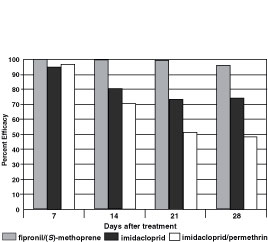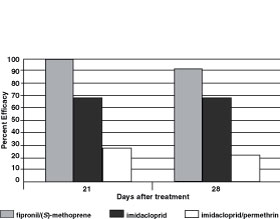|
The INTERNATIONAL JOURNAL of APPLIED RESEARCH In Veterinary Medicine |
 |
| Current Issue |
| Previous Issues |
| Reprint Information |
| Back to The International Journal of Applied Research in Veterinary Medicine |
Comparative
Efficacy of a Combination of Fipronil/(S)-Methoprene, a Combination of Imidacloprid/Permethrin,
and Imidacloprid Against Fleas and Ticks When Administered Topically
to Dogs
John W. McCall, MS, PhD*
Roberto Alva, DVM, MS, PhD
Jennifer P. Irwin, BS
Doug Carithers, DVM
Albert Boeckh, DVM, PhD, DACVCP
*University of Georgia, College of Veterinary Medicine, Athens, Georgia
Merial Limited, Athens, Georgia
Merial
Limited, Duluth, Georgia
KEY WORDS: Flea, tick, dog, efficacy, fipronil, imidacloprid, permethrin
ABSTRACT
This study compared the efficacies of three commercially
available topical (spot-on) ectoparasiticides, fipronil/(S)-methoprene,
imidacloprid/permethrin and imidacloprid alone against fleas and ticks
on dogs. Each product was administered topically once on Day 0 at
the recommended label dose and according to the instructions for use.
Challenges occurred weekly with 100 Ctenocephalides felis, and on
weeks 3 and 4 of the study with 50 Rhipicephalus sanguineus on each
dog. Dogs treated with each of the products had significantly (p<0.05)
fewer fleas than the untreated controls at each post-treatment count,
however only fipronil/(S)-methoprene combination maintained 100% efficacy
through day 21. Dogs treated with fipronil/(S)-methoprene had significantly
(p<0.05) fewer fleas than the dogs treated with the combination
of imidacloprid/permethrin and imidacloprid alone at each evaluation
through Day 28. Dogs treated with imidacloprid alone had significantly
(p<0.05) fewer fleas than dogs treated with the combination product
imidacloprid/permethrin on Day 28. Dogs treated with fipronil/(S)-methoprene
and imidacloprid/permethrin had significantly (p<0.05) fewer ticks
than untreated controls at both Days 21 and 28, however the fipronil/(S)-methoprene
group had significantly (p<0.05) fewer ticks than imidacloprid/permethrin
on Days 21 and 28. Overall, in this study the combination of fipronil/(S)-methoprene
provided consistent and high levels of efficacy against fleas and
ticks throughout the entire month, significantly superior to that
of either imidacloprid/permethrin or imidacloprid alone. Additionally,
imidacloprid alone performed better against the cat flea (Ctenocephalides
felis) than the combination product of imidacloprid/
permethrin.
INTRODUCTION
Despite the discovery and development of newer-generation
topical (Spot-on) ectoparasiticides for dogs and cats, which have
significantly superior efficacy compared with
shampoos and dips,1 practitioners and researchers continue
to search for products that provide increased duration and spectrum
of activity. Today, the veterinary practitioner has the opportunity
to select from several options, including combinations of topical
insecticides and acaracides for controlling fleas and ticks on companion
animals.
The potential benefits of combination products are numerous, such as prolonging duration of activity and broadening the ectoparasitide spectrum, while providing a convenient single administration to treat multiple parasites. Additionally, combination products can be used as a strategy to manage variations in parasite susceptibility.2,3
The
objective of this study was to confirm and compare the adulticidal
activity of commercially available formulations of fipronil/(S)-methoprene
(Frontline Plusฎ, Merial Limited, Duluth, Ga.), imidacloprid/permethrin
(K9-Advantixฎ, Bayer Animal Health, Shawnee Mission, Ks.), and imidacloprid
(Advantageฎ, Bayer Animal Health, Shawnee Mission, Ks.) alone against
fleas and ticks. Each product was administered topically to dogs,
once on Day 0, at the recommended label dose and according to the
instructions for use. This study did not include cats, as one of the
products tested (imidacloprid/permethrin) is not approved for use
on this species.
MATERIALS AND METHODS
A total of 24 healthy
beagle dogs, ranging in weight from 5.1 to 8.4 kg were studied in
this single-center, randomized, blinded, controlled trial, conducted
at TRS Laboratories in Athens, Georgia. A pretreatment infestation
using 100 Ctenocephalides felis fleas was conducted on Day 8 to confirm
the flea-holding capability of the study dogs. Fleas were counted
on Day 7 for allocation purposes and dogs were ranked within sex
based on these pretreatment flea counts. The four most heavily infested
males formed the first replicate; the next four most heavily infested
males formed the second replicate, and so on. This process was repeated
for the females.
Within replicates, each dog was randomly allocated to one of four treatment groups and assigned a color code by lottery. Dogs in Group 1 received a placebo solution at a volume of 1.0 mL. Dogs in Groups 2, 3, and 4 received 1 pipette of fipronil/(S)-methoprene, imidacloprid/permethrin, or imidacloprid, respectively, once on Day 0. Pipette size was based on individual body weight and applied according to the instructions on the label. All dogs were infested with approximately 100 unfed C felis fleas on Days 6, 13, 20, and 27. Live fleas were removed and counted 24 hours after each infestation (i.e., on Days 7, 14, 21, and 28). Dogs were also infested with approximately 50 unfed Rhipicephalus sanguineus ticks on Days 19 and 26. Live ticks were counted and removed on Days 21 and 28.
Flea counts for each animal were transformed to the natural logarithm of (count+1) for calculation of geometric means. Percent reduction from the control group was calculated. Treatment groups were also compared using an exact Kruskal-Wallis/Wilcoxon rank sum test followed by pair-wise comparisons (SAS version 8.1). Each ectoparasiticide was compared to the untreated control, and the fipronil/(S)-methoprene combination was compared with each of the other two groups. The same procedure was used for the ticks. For flea counts, imidacloprid/permethrin was also compared with imidacloprid. A significance level of 0.05 was used and all testing was two-sided, in a two-step procedure; pair-wise comparisons were made only if the overall test of treatments was significant at a p value of 0.05.
RESULTS
Dogs treated with each of the three products had significantly fewer fleas (p<0.05) than the untreated controls at each post-treatment infestation through Day 28; however, only the fipronil/(S)-methoprene combination provided complete efficacy (100%) through Day 21 following treatment. In contrast, efficacy for the other products had declined to 51% (imidacloprid/permethrin) and 73% (imidacloprid) by Day 21 (Table 1).
Dogs treated with the fipronil/(S)-methoprene combination had significantly fewer fleas (p<0.05) than the dogs treated with the combination of imidacloprid/permethrin and significantly fewer fleas (p<0.05) than dogs treated with imidacloprid alone at each evaluation through Day 28. Dogs treated with imidacloprid had significantly fewer fleas (p<0.05) than dogs treated with imidacloprid/permethrin combination on Day 28 (Table 1, Figure 1).
Although dogs treated
with fipronil/(S)-methoprene or imidacloprid/permethrin had significantly
fewer ticks (p<0.05) than the controls at both Day 21 and Day 28,
the dogs treated with fipronil/(S)-methoprene had significantly fewer
ticks (p<0.05) than those treated with imidacloprid/permethrin
at both of these time points (Table 2, Figure 2).
DISCUSSION
This study demonstrated that the combination of fipronil/(S)-methoprene provided excellent control of adult fleas for the entire 1-month treatment period. The flea efficacy of the imidacloprid/permethrin combination product was statistically lower than that of fipronil/(S)-methoprene at all challenge dates. Both imidacloprid/permethrin and imidacloprid alone performed satisfactorily up to Day 7, but their efficacy declined substantially, falling below the accepted standard of 95% efficacy against fleas in counts performed on Days 14, 21, and 28. Of particular interest was the fact that throughout the study the combination of imidacloprid/permethrin provided lower efficacy against fleas than imidacloprid alone. This difference was significant (p<0.05) on Day 28.
These results contradict purported synergy shown in a previously reported in-vitro study,4 where separate solutions containing imidacloprid, permethrin, or both compounds were exposed to an isolated nerve preparation. A synergistic activity effect claimed in the previous in-vitro study was not validated by this in-vivo study.
Natural differences in susceptibility of strains of parasites to insecticides/acaricides are expected in the field setting57 and may help to explain the results seen in this study with imidacloprid alone and the combination of imidacloprid/permethrin.
This study further demonstrated that fipronil/(S)-methoprene provided higher levels of efficacy against Rhipicephalus sanguineus (the brown dog tick) at weeks 3 and 4 after treatment compared to the imidacloprid/permethrin combination. Since all of these products are labeled for once-monthly administration, maintenance of activity throughout the entire treatment interval is critical. The imidacloprid/permethrin combination did not provide satisfactory efficacy against ticks.
In summary, the combination of fipronil/(S)-methoprene
provided consistent and high levels of efficacy against fleas and
ticks throughout the entire month, significantly superior to that
of either imidacloprid/permethrin or imidacloprid alone. Additionally,
imidacloprid alone performed better against the cat flea (Ctenocephalides
felis) than the combination product of imidacloprid/permethrin.
REFERENCES
1. Dryden MW. Highlights and horizons in flea control. Compendium of Continuing Education for the Practicing Veterinarian. 1999;April:296.
2. Gloyd K, Dryden M, Blagburn B, Hinckle N, Payne P, Kwochka, K. Flea resistance to insecticides Roundtable on strategies for long-term flea control. Vet Forum, 1999: June;4451.
3. Marsella R. Advances in flea control. Vet Clin North Am Small Anim Pract. 1999; 29:14071424.
4. Product guide, Bayer Animal Health.
5. Bossard RL, Dryden MW, Broce AB. Insecticide susceptibilities of cat fleas (Siphonaptera: Pulicidae) from several regions of the United States. J Med Entomol. 2002;39:742746.
6. Bossard RL, Hinkle NC, Rust MK. Review of insecticide resistance in cat fleas (Siphonaptera: Pulicidae). J Med Entomol. 1998;35:415422.
7.
Kilonzo BS, Gisakanyi ND. Observations on the susceptibility
of Ctenocephalides felis (Siphonaptera:Pulicidae) to malathion and
permethrin in Tanzania. Med Vet Entomol. 1988;2:325329.
Table
1. Geometric mean flea (Ctenocephalides felis) counts (and reduction from control) for dogs
treated on Day 0 with fipronil/(S)-methoprene,
imidacloprid/permethrin, imidacloprid, or remaining untreated
Day Control Fipronil/(S)-methoprene Imidacloprid/permethrin Imidacloprid
-7 89.6 85.5 85.0 87.3
7 86.0 0.0* (100%) 2.7* (96.9%) 3.8* (95.5%)
14 98.2 0.0* (100%) 28.6 (70.9%) 19.3 (80.4%)
21 90.5 0.0* (100%) 44.0* (51.4%) 24.1* (73.4%)
28 95.5 3.7* (96.2%) 49.3* (48.4%) 24.5* (74.3%)
*Significantly different from control (p<0.05).
Significantly different from fipronil/(S)-methoprene (p<0.05).
Significantly different from imidacloprid (p<0.05).

Figure 1. Percent
reduction in flea counts compared to control for dogs treated on Day
0 with fipronil/(S)-methoprene,
imidacloprid/ permethrin or imidacloprid.
Table
2. Geometric mean tick (Rhipicephalus sanguineus) counts (and reduction from control) for dogs
treated on Day 0 with fipronil/(S)-methoprene,
imidacloprid/permethrin, imidacloprid, or remaining untreated
Day Control Fipronil/(S)-methoprene Imidacloprid/permethrin Imidacloprid
21 30.7 0.4* (98.6%)
9.9* (67.8%)
22.3 (27.3%)
28 43.2 3.8* (91.1%)
13.4* (68.9%)
33.5 (22.4%)
*Significantly different from control (p<0.05).
Significantly different from fipronil/(S)-methoprene
(p<0.05)

Figure 2. Percent
reduction in tick counts compared to control for dogs treated on Day
0 with fipronil/(S)-methoprene,
imidacloprid/ permethrin or imidacloprid.
ISSN# 1542-2666